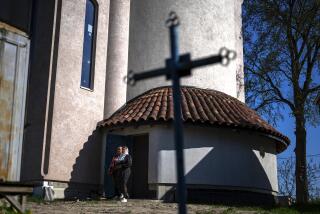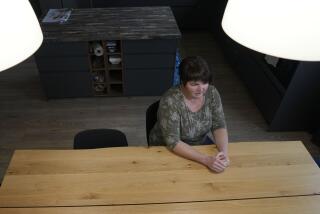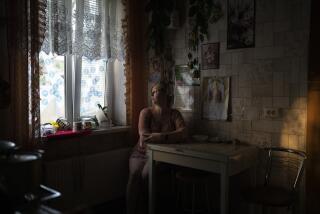Serb Province Simmers Amid Uneasy Quiet
SVINJARE, Serbia and Montenegro — Burned houses line the road that cuts through rolling potato fields and meadows of wildflowers. Some of the buildings are so damaged, their roofs have collapsed -- stark testament to an ethnic struggle that is far from over in this corner of Kosovo.
Five years ago, ethnic Albanians’ houses were being destroyed. Now, the victims are Serbs.
“We said, ‘Why are you doing this?’ when the kids started setting the houses on fire,” said Selvie Rexhepi, 26, an ethnic Albanian whose family runs a small shop that sells crackers and drinks. The ethnic Albanian arsonists said: “ ‘They burned us, and now we’re burning them.’ ”
Rexhepi and her family, like many ethnic Albanians in town, stayed in their homes while the Serbs’ houses were turned to ashes. A few ethnic Albanians went outside to hoist Albanian flags to signal that their houses should be passed over by the mob.
The village used to be half Serb and half ethnic Albanian. Now, with its 135 Serb-owned houses damaged, many of them seriously, it is unclear how many Serbs will return.
Svinjare was one of 30 towns and villages in Kosovo swept by violence March 17 and 18. Mobs, some armed with heavy weapons, damaged 730 houses in Kosovo -- the vast majority owned by Serbs -- and 35 religious sites, mostly Serbian Orthodox churches.
It was the worst violence since 1999, when hundreds of thousands of ethnic Albanians were displaced by Serbian security forces. Kosovo has been under United Nations control since North Atlantic Treaty Organization airstrikes drove out the Serbian forces. But the province remains part of Serbia and Montenegro, the successor state to Yugoslavia.
In clashes during the province-wide rioting in March, 19 people were killed. Eight were Serbs killed by Albanian gunfire and eight were Albanians killed by Serbian gunfire, said Neeraj Singh, a spokesman for the U.N. Mission in Kosovo. The other three deaths were caused by international security forces trying to bring the situation under control.
The incidents have precipitated a review by the United Nations of its policies in the province, which have done little so far to create either jobs or an effective police force despite millions of dollars spent. The March violence showed that neither the local police nor the international police, brought by the U.N. from member countries, were able to maintain control. In most cases, authorities helped Serbs evacuate their homes but then stood by while ethnic Albanian mobs set the houses ablaze.
The violence began after three ethnic Albanian teenagers drowned in a swollen river in northern Kosovo. Widely publicized news reports, based on an account by a fourth boy who had survived, said two Serbian youths and a dog had chased the Albanians into the swirling waters where they drowned.
An investigation by a U.N. prosecutor found no criminal wrongdoing in connection with the deaths, and officials from the world body criticized the ethnic attacks and the Albanian-language media for having incited the rioters.
Aware that the violence could defeat the province’s national aspirations, Bajram Rexhepi, Kosovo’s prime minister, created an $11-million fund to repair the houses damaged by the mobs.
In an interview, Rexhepi said he expected the work to be completed by November.
“Those events in March set us back,” he said. “They made a very bad picture of Kosovo -- that it’s not ready for final status.”
The term “final status” is used by the United Nations for the determination about Kosovo’s future standing and whether the province’s legal status will be that of an independent country.
Javier Solana, the European Union’s senior foreign policy official, asked Rexhepi during a visit this month whether the rebuilding could be completed more quickly.
The prime minister said that he would like the Serbs to return to Svinjare but that he wanted them to treat the ethnic Albanian majority government in Pristina, the provincial capital -- not the Serbian government in Belgrade, the Serbian capital -- as the ruling authority.
“We have to do our part, the rebuilding.... But it’s important to talk with the Serbian citizens here in Kosovo about their needs, and they have to solve their problems with Pristina, not with Belgrade or through representatives who have some delusion that Kosovo could ever again be under the jurisdiction of Serbia,” he said.
Rexhepi, along with Kosovo’s president, Ibrahim Rugova, and local intellectuals blame U.N. policies for the riots. Rexhepi said the lack of clarity about the timetable and progress of Kosovo to independence had upset ethnic Albanians.
Like most other ethnic Albanians in Kosovo, neither Rexhepi nor Rugova is willing to examine the society’s deep bias against Serbs and its willingness to use some of the same ethnic-cleansing techniques that the Serbs used against the ethnic Albanians.
“The March events happened in a spontaneous fashion, and then extremists used the violence.... These were signs of frustration,” Rugova said.
“Then comes the issue of Kosovo’s independence. And people are still fearful about their future.... They are fearful about falling under Belgrade’s dominance in any fashion, and the experience of the war is still fresh,” said Rugova, who was captured by the Serbs during the war and held first in Kosovo and later in Belgrade while his family fled.
Kosovo is mostly quiet now, although early this month a Serbian teenager was shot to death by Albanian youths for no apparent reason.
No one expects the province to remain quiet. International experts and Kosovars agree that there has been no change in the underlying causes for the March rampages: an explosive mix of ethnic hatred, joblessness and the lack of certainty about Kosovo’s future status.
Without drastic action, “this society will continue to push out minorities and ultimately consume its own wafer-thin layer of liberal intelligentsia,” said a report titled “Collapse in Kosovo” issued April 22 by the International Crisis Group, a Brussels- and Washington-based nonprofit research organization that has observers in Kosovo.
“I don’t think any of the triggers for the March violence have disappeared,” said Milazin Krasniq, a political columnist and analyst. “Poverty, violence, the U.N. remains arrogant, the Kosovo government is still ineffective, Serbs still pursue their own agenda, and among Albanians there are extreme elements that want to impose their own projects.”
Perhaps the most disturbing fact is that many Kosovo Albanians do not care whether the Serbs return. Selvie Rexhepi of Svinjare said it had been six years since she talked with a Serb -- until early this month, when she spoke with one who had helped her family during the war.
“I don’t think they will come back here,” she said. “Everyone is making such a fuss about this, but three of my uncles disappeared during the 1999 war.”
She added: “Even before the war, they didn’t buy at my store, and we would not have sold to them.”
Rubin was recently on assignment in Serbia and Montenegro.










